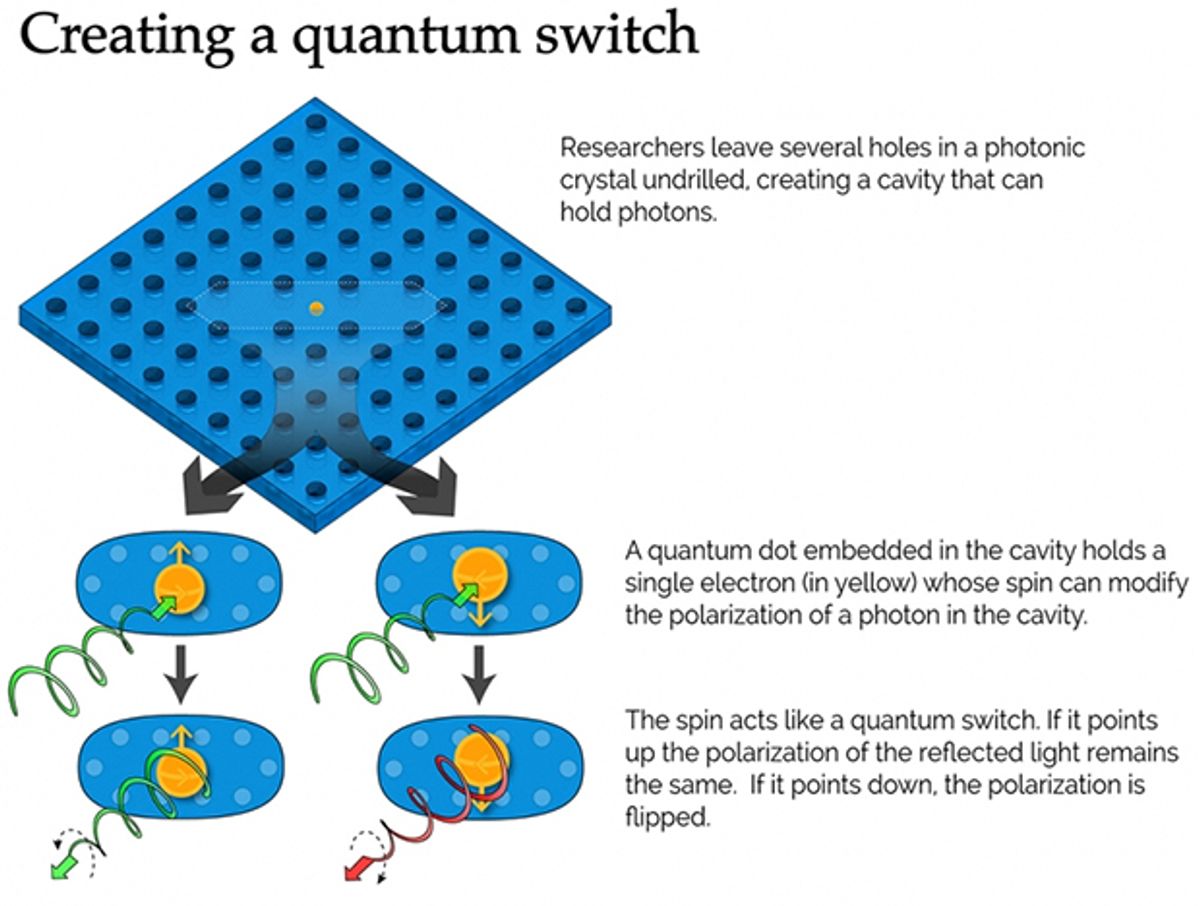Essential for so-called quantum networks and quantum computers is something called a quantum bit, or qubit, which would replace the traditional bits that are stored or transmitted in today’s computers and optical networks. It consists of an ion with an unpaired electron that has two spin states—up or down, or a 0 and 1 in a binary system. But under some conditions, these qubits can be made to have both the 0 and 1 state simultaneously—a quantum state.
One of the problems researchers have faced in incorporating qubits in optical networks is getting the photons to strongly interact with the qubits in a solid-state device. The aim has been to develop something akin to an electro-optic modulator that uses electronic signals to modulate properties of light in today’s optical networks.
Researchers at the University of Maryland have developed a novel design that may have achieved that aim by “combining the light-trapping of photonic crystals with the electron-trapping of quantum dots.”
During the course of research described in the journal Nature Nanotechnology, the researchers built a device based on the much theorized idea that nanophotonic cavities or waveguides can bring photons and qubits together in a solid-state device. The quantum phase switch the Maryland researchers have devloped based on this concept is capable of modifying the polarization of a photon that comes in contact with the spin of an electron trapped in the cavity. This was achieved by creating photonic crystal with a cavity that had a quantum dot trapped in it and was capable of attracting certain wavelengths of light.
“Our platform has two major advantages over previous work,” says Shuo Sun, the first author of the paper, in a press release. “The first is that the electronic qubit is integrated on a chip, which makes the approach very scalable. The second is that the interactions between light and matter are fast. They happen in only a trillionth of a second—1,000 times faster than previous studies.”
To build the switch, the researchers started with photonic crystals that had already been well characterized for trapping light. The researchers assembled these photonic crystals by layering thin sheets of semiconductor material on top of each other and then drilling holes into the material along a grid pattern.
Where the researchers diverted from the norm with these photonic crystals was intentionally leaving a region of the grid pattern undrilled. This created a defect in the crystal that acted like a cavity, or a hole, in which only those photons with a certain kind of energy—in this case, infrared photons—could enter or leave.
They then embedded a quantum dot into that cavity. Quantum dots behave like artificial atoms. So, in this case, the researchers used quantum dots with a single electron orbiting it, not unlike an ion.
With the quantum dot embedded into the cavity of the photonic crystal, it was critical that the resonant frequency of the quantum dots matched the energy of the photon, which in this case is infrared. By engineering dots that emit at different optical frequencies, it was possible to tune the wavelength at which the device operates.
Once the matched photons and quantum dots begin to interact, the spin of the electron modifies the polarization of the photon. A magnetic field is applied to the quantum dot to change the spin of the electron to either up or down. Then a technique called optical pumping is used to cool the spin so that it points along the magnetic field direction. In this way, it is possible to control the orientation of the spin using fast optical pulses.
“The switch that we built can be used as a fundamental building block to make quantum computers and quantum networks,” said Edo Waks, one of the paper’s authors, in an e-mail interview with IEEE Spectrum. “It plays a very similar role to an electrical transistor in a regular computer.”
The research team says it is working to scale the system to multiple quantum switches in order to perform more complex quantum computational operations.
Waks added: “We are also working to develop devices that work at telecom wavelengths so that we can manipulate and entangle photons that are at the correct wavelength for fiber optical communication.”
Dexter Johnson is a contributing editor at IEEE Spectrum, with a focus on nanotechnology.


